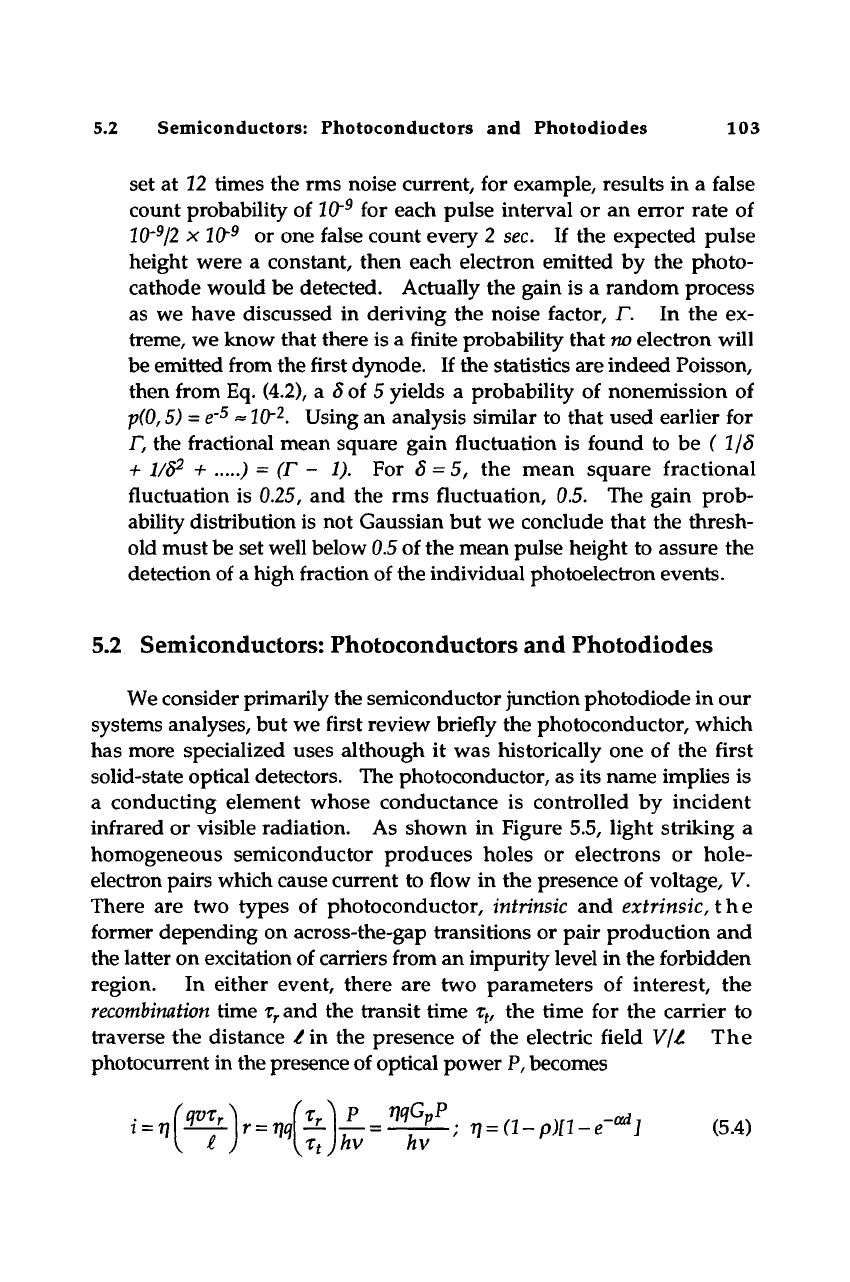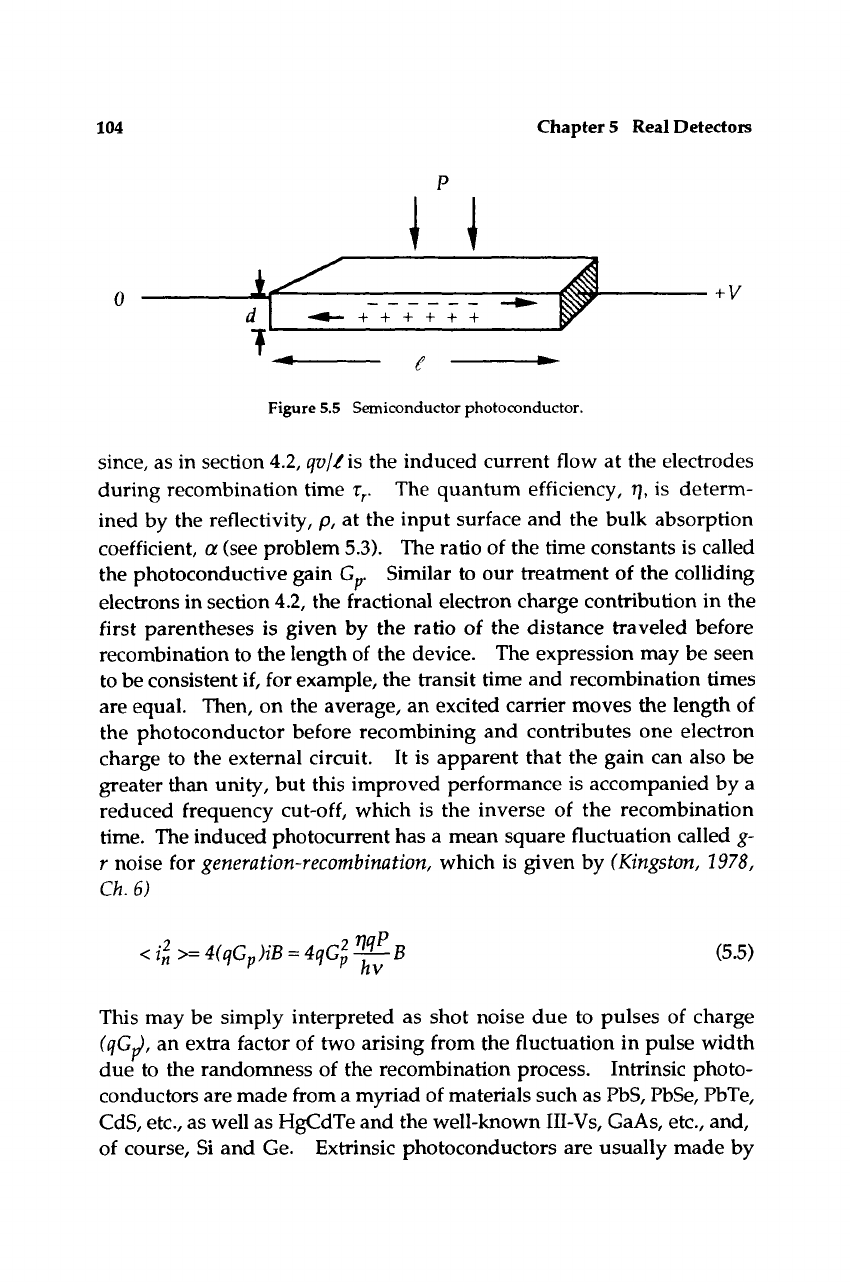
5.2 Semiconductors: Photoconductors and Photodiodes 103
set at 12 times the rms noise current, for example, results in a false
count probability of
10"^
for each pulse interval or an error rate of
10'^/2
X
10-^
or one false count every 2 sec. If the expected pulse
height were a constant, then each electron emitted by the photo-
cathode would be detected. Actually the gain is a random process
as we have discussed in deriving the noise factor, P. In the ex-
treme, we know that there is a finite probability that
no
electron will
be emitted from the first dynode. If the statistics are indeed Poisson,
then from Eq. (4.2), a 5 of 5 yields a probability of nonemission of
p(0,5) =
e'^
«
20'2.
Using an analysis similar to that used earlier for
r, the fractional mean square gain fluctuation is found to he ( 1/5
-h
1/5^
+ ) = (r - 1), For 5 = 5, the mean square fractional
fluctuation is 025, and the rms fluctuation, 05. The gain prob-
ability distribution is not Gaussian but we conclude that the thresh-
old must be set well below
0.5
of the mean pulse height to assure the
detection of a high fraction of the individual photoelectron events.
5.2 Semiconductors: Photoconductors and Photodiodes
We consider primarily the semiconductor junction photodiode in our
systems analyses, but we first review briefly the photoconductor, which
has more specialized uses although it was historically one of the first
solid-state optical detectors. The photoconductor, as its name implies is
a conducting element whose conductance is controlled by incident
infrared or visible radiation. As shown in Figure 5.5, light striking a
homogeneous semiconductor produces holes or electrons or hole-
electron pairs which cause current to flow in the presence of voltage, V.
There are two types of photoconductor, intrinsic and extrinsic, the
former depending on across-the-gap transitions or pair production and
the latter on excitation of carriers from an impurity level in the forbidden
region. In either event, there are two parameters of interest, the
recombination
time
r^
and the transit time
T^,
the time for the carrier to
traverse the distance /in the presence of the electric field Vjl The
photocurrent in the presence of optical power
P,
becomes

104
Chapter 5 Real Detectors
Figure 5.5 Semiconductor photoconductor.
since, as in section 4.2, qv//is the induced current flow at the electrodes
during recombination time r^. The quantum efficiency, rj, is determ-
ined by the reflectivity, p, at the input surface and the bulk absorption
coefficient, a (see problem 5.3). The ratio of the time constants is called
the photoconductive gain G^. Similar to our treatment of the colliding
electrons in section
4.2,
the fractional electron charge contribution in the
first parentheses is given by the ratio of the distance traveled before
recombination to the length of the device. The expression may be seen
to be consistent if, for example, the transit time and recombination times
are equal. Then, on the average, an excited carrier moves the length of
the photoconductor before recombining and contributes one electron
charge to the external circuit. It is apparent that the gain can also be
greater than unity, but this improved performance is accompanied by a
reduced frequency
cut-off,
which is the inverse of the recombination
time.
The induced photocurrent has a mean square fluctuation called g-
r noise for
generation-recombination,
which is given by (Kingston, 1978,
Ch.6)
<i^>=4(qGp)iB
=
4qG}^B
(5.5)
This may be simply interpreted as shot noise due to pulses of charge
(qGJ, an extra factor of two arising from the fluctuation in pulse width
due to the randomness of the recombination process. Intrinsic photo-
conductors are made from a myriad of materials such as PbS, PbSe, PbTe,
CdS,
etc., as well as HgCdTe and the well-known III-Vs, GaAs, etc., and,
of course. Si and Ge. Extrinsic photoconductors are usually made by
Get Optical Sources, Detectors, and Systems now with the O’Reilly learning platform.
O’Reilly members experience books, live events, courses curated by job role, and more from O’Reilly and nearly 200 top publishers.

